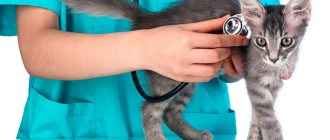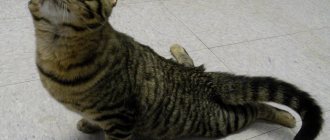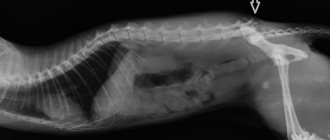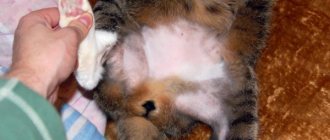What additional steps can be taken?
Once a competent veterinarian has been found and the necessary instructions have been received, the owner can speed up the treatment process by taking additional measures. Massage will help improve your cat's condition. It should be performed with light but fairly intense movements. This way the muscles will not have time to quickly atrophy. The massage must be performed every day for five sessions lasting ten minutes.
Do not give up water procedures. Even if the cat shows dissatisfaction. Swimming is very effective in the recovery process. It is enough just to put the animal in the water a couple of times a week, where he would strain, trying to move them. At the same time, the cat needs to be supported.
Also, the basic treatment of paralyzed legs can be supplemented with ball exercises. Place on a ball of appropriate size. In this case, the paws should touch the floor. Your task is to make the cat begin to rest its limbs on the floor. To do this, slowly roll the ball back and forth.
Over time, when the paralysis of the hind legs subsides and sensitivity returns to them, try tickling the cat behind the ear. The reflex will work and he will attempt to reach the ear with his hind paw to scratch it. This will also be a kind of training.
If the treatment was not effective.
It happens that all the efforts made remain without results. In this case, you can either euthanize the pet or purchase a special wheelchair for it. Very soon the cat will learn to use this simple device independently and will not experience any difficulties in moving.
Some people believe that cats are animals with a minimum number of depressing problems, especially those related to health. But like any animals, they have a number of genetic, infectious, and viral predispositions to pathologies. If a pet's hind legs fail, it is unlikely to determine the true cause without the help of a veterinarian. This is a serious dysfunction of the body that can lead to death, and it is impossible to procrastinate.
First aid at home
If the hind limbs fail, the cat should be seen by a doctor as soon as possible. First of all, you need to take the following measures:
- If the animal is panicking, it should be calmed down. You can talk to the cat in a gentle voice, stroke its head. It is important that the animal moves as little as possible.
- If trauma has led to paralysis, the cat must be fixed in one position. This should be done carefully so that the cat does not get nervous and try to escape. There should be a hard, hard surface underneath the animal. All movements should be kept to a minimum.
- If your limbs start to get cold, you can put a heating pad under them. It should not be very hot to avoid burns.
- If the animal is vomiting severely, the cat should be placed on its side so that the vomit does not clog the airways.
- If the cat has definitely not been injured, it can be placed on a soft surface (put a blanket in the carrier).
You need to take your animal’s veterinary passport with you to the clinic. Disposable diapers and clean napkins will not hurt. If it is cold outside, the animal should be covered.
Diagnostics
There can be many reasons for hind leg failure in cats. If the owner himself has not witnessed the injury that the cat received, a large-scale diagnosis will have to be carried out.
At the clinic, the veterinarian will conduct the following tests:
- Take a general urine and blood test. They can be used to determine the presence of inflammatory processes in the body.
- Conducts an external inspection. Test the sensitivity of the limbs and reflexes.
- Take an x-ray of the spine. It shows the presence of fractures, tumors, and dislocations.
- It is possible to take an x-ray using contrast fluid.
- If an infection is suspected, the doctor may take a bacterial culture.
- If damage to internal organs is suspected, the doctor will perform an ultrasound.
- If necessary, an MRI of the brain and spine can be done.
You might be interested in: Bald patches in a cat: how to distinguish normal from pathology?
Herniated discs and spinal cord inflammation
Herniated discs (displacement of an intervertebral disc that presses on the spinal cord, thereby causing complete or partial paralysis of the hind legs) is a rare disease that affects older cats. Another reason is the peculiarity of the breed. Cats with short tails show changes in the sacral spine. Symptoms begin with poor posture and end with complete paralysis of the animal.
Inflammation of the spinal cord (myelitis) is a disease that is infectious in nature, most often resulting from poisoning, the presence of worms, injuries, or suppuration in the uterus during pregnancy. This disease can be local in nature, and in particularly severe cases it affects the entire spinal cord. The cat behaves very aggressively, there is a fever, problems with the gastrointestinal tract, urinary retention, severe pain, and coma. The pet often licks or bites its lower paws.
Thromboembolism
Thromboembolism of the femoral arteries occurs when a vessel is blocked by a blood clot that has broken away from its site of origin. This is a very serious disease, the likelihood of cure is low, and usually death occurs within 2-4 days from the moment of paralysis of the limbs.
The symptoms are as follows: at first it is very acute, the cat screams in pain, when trying to touch it responds with aggression, shakes its hind legs alternately, later they refuse, become much colder than the front ones, and movement becomes possible only at the expense of the front ones. The animal is almost motionless, does not want to eat or drink, prefers dark, cool places.
Vitamin deficiency is possible in the absence of sunlight, as well as in cases of infectious diseases suffered by animals or prolonged use of antibiotics. These reasons are based on a small amount of vitamin B1 in the body. Signs of vitamin deficiency: lethargy, drowsiness, fatigue, weight loss, anemia.
Kidney failure leads to disruption of the entire genitourinary system. The most identifying symptoms of this disease are a decrease in the amount of urine, and then its absence altogether. Lethargy, apathy, poor appetite, refusal to eat, later vomiting, diarrhea, fever.
Diagnostic procedures
The examination will determine the presence of damage to the spine and bone tissue.
To identify paralysis of the larynx and other parts of the body, the veterinarian conducts an external examination of the pet and checks reflexes. Depending on the location of the damage, diagnostic methods are prescribed, such as:
- radiography of the affected area;
- computed tomography or magnetic resonance imaging;
- electromyography;
- Doppler ultrasound if there is a suspicion of vascular disorders;
- Ultrasound of the diseased area;
- laryngoscopy for laryngeal paraparesis;
- myelography.
Hip dysplasia
Hip dysplasia is abnormal development of the hip joint, thickening of the muscles, resulting in an increased likelihood of dislocation or fracture. Symptoms: the cat steps unsteadily from paw to paw, limps, and prefers to crawl around the apartment.
Possible decrease in activity, muscle atrophy, and curvature of limbs. Reasons: sedentary lifestyle, excess protein and calories.
Cardiomyopathy and stroke
Cardiomyopathy is a thickening of the walls of the heart and an increase in its volume. The disease rarely leads to complete dysfunction of the hind legs, but it does happen. The main reason is that the heart contracts poorly, the muscles do not receive the required amount of oxygen, and the paws atrophy. Symptoms: shortness of breath, cough, apathy, drowsiness.
The cause of paralysis can be a stroke (impaired vascular patency). This disease affects old, sedentary, emaciated animals. The cat is choking, cannot swallow food normally, and has profuse salivation. In severe cases, failure of the lower or upper legs. If medical assistance is not provided to the animal in time, this leads to complete paralysis of the entire body.
Cardiomyopathy, stroke
An increase in the volume of the heart or thickening of its walls (cardiomyopathy) sharply leads to paralysis of the limbs. But this still happens. The cause is a lack of oxygen reaching the muscles. Associated symptoms of the disease are shortness of breath, drowsiness of the animal, cough, and apathetic state. Since heart surgery cannot be performed on cats, treatment will be conservative. Veterinarians often prescribe Diltiazem or Atenolol, and complete rest is recommended for the animal.
Sometimes the cause of limb paralysis is a stroke. It often occurs in old or sedentary animals. Treatment is possible only with the assistance of an experienced veterinarian. He will prescribe antipsychotics, painkillers and anti-convulsions medications.
Treatment of limb paralysis
The best thing to do if your cat's back or front legs are failing is to immediately contact a veterinarian. If this is not possible, you need to consult a doctor by phone or online. Treatment cannot be started without an accurate diagnosis; it may be useless or lead to rapid death.
If the diagnosis is determined, there are ways to treat this disease at home:
- Treatment of diseases associated with spinal injuries in most cases requires surgical intervention. At home, you can treat them only in case of a mild form.
If an animal has fallen from a great height and its hind legs have failed, the veterinarian will most likely prescribe medications such as: Traumeel + Tsel, Metipred, Milgama, Maralgin.
In some cases, myelostimulation, foot massages, and acupuncture help. If the cat cannot defecate normally, he is prescribed laxatives and the urine is pumped out with a syringe. For myelitis, the main care is to prevent bedsores from developing. You need to massage your paws using camphor oil or alcohol. There is a need to sometimes turn the cat over and systematically empty its rectum. Thromboembolism of the femoral arteries is treated if tissue necrosis is not observed, and the sensitivity of the paws is at least slightly preserved. Then the cat is prescribed physical therapy and anticoagulants: Clopidogrel, aspirin, Heparin (you need to be as careful as possible with it, because the wrong dosage leads to internal bleeding). Vitamin deficiency is almost always correctable if the disease is not aggravated. You need to add nutrients to your cat's diet. Group A vitamins are found in fish, egg yolks, and vegetables. B vitamins are present in vegetable and animal fats. One of the most important vitamins in this situation is found in fish, eggs and milk. Hip dysplasia. If the disease is detected in the early stages, there is no reason to worry. It is necessary to fix the cat's limb to reduce the load on it. Supplements with Glucosamine and Chondroetin and anti-inflammatory injections are prescribed. Stroke. During a seizure, carefully place the cat on its side and check for vomit in its mouth to prevent it from choking. Then urgently take her to the veterinarian or call a doctor at home. Treatment for stroke is only possible with a veterinarian!
He prescribes drugs for convulsions, painkillers, and antipsychotics. Cardiomyopathy. Heart surgery is contraindicated for cats, so treatment is always medicinal, which must be prescribed by a doctor. The medications needed are drugs that slow the heart rate, such as Atenolol or Diltiazem. In order not to aggravate the situation, the cat needs complete rest; sudden noises are undesirable. For kidney failure, the best treatment is to simply follow your doctor's recommendations. It is necessary to restore the water and salt balance, for this the cat is prescribed a special low-protein diet, steroids and B vitamins for weight gain. To reduce or eliminate intoxication, physiological solutions are used.
Cats, if they do not have congenital pathologies and are provided with a quality life, rarely suffer from health problems. However, as people age, they develop diseases that require treatment. Sometimes a young pet that is only one year old can also suffer from them. In some cases, owners are faced with the fact that the cat cannot walk well with its hind legs, and this cannot but cause concern. With such a violation, the cat’s condition seriously deteriorates, and she cannot live a full life. It is quite difficult, and most often impossible, to independently determine the cause of this phenomenon, and therefore you should urgently show your four-legged friend to a veterinarian.
Causes
There are many reasons for problems with mobility in a cat, when its hind legs begin to move apart, fail, and even be taken away.
Now experts call the main factors that caused the cat to walk poorly:
:
Advanced otodectosis
– if the ear mite is not treated and the cat develops severe otitis media, over time the inflammation spreads to the brain, causing damage to its membranes.
It leads to the appearance of various paralysis, and first of all, the hind legs lose normal mobility; Traumatic injuries to the spine
- with this phenomenon, paralysis spreads to the hind legs and tail.
The cat completely loses the ability to control the body, starting from the lower back, which causes serious disturbances not only in movement, but also in digestion; Lesions of the spinal cord
, which lead to necrosis of its tissues or severe compression of them - in this case, the cat’s hind legs are always taken away.
This cause of the problem also includes cancer. Treatment at a time when paralysis has already begun is usually not effective, and the question of euthanizing the cat may be raised; Thromboembolism
- with this disease, paralysis in the animal occurs sharply against the background of blockage of large vessels by a detached blood clot.
This disease is very serious and in 95% of cases leads to the death of the animal within 36-72 hours following paralysis; Vitamin deficiency
- when vitamin deficiency occurs in the animal’s body, all vital processes are disrupted, which changes the functioning of the ligaments and joints.
In such a situation, weakness of the cat’s hind legs necessarily develops. The animal's movement is seriously impaired. The cat looks unkempt and walks, dragging its hind legs and noticeably wobbling its pelvis; Hip dysplasia
- with this pathology, the development of the joint occurs incorrectly, due to which the muscles become significantly thinner and begin to negatively affect the hip, leading to chronic subluxation, which impairs the animal’s mobility.
Often, due to the disease, the hind legs become bent, which causes the cat to move especially poorly; Stroke
is a pathology that occurs not only in humans. The cat can also become a victim of cerebral hemorrhage. When a disease occurs, the cat receives brain damage, and if the motor center is affected, a loss of coordination of movement and mobility occurs, and first of all, the owner will notice that the cat’s hind legs have become tangled.
After the owner notices that the cat is afraid to stand on its hind legs, it is difficult for him to get up and sit down, and sometimes he even falls on his side when moving backwards, the pet must be urgently shown to a veterinarian on the day the violations are discovered. It is impossible to independently diagnose the cause of the problem and carry out high-quality therapy - only a doctor can tell you what to do and whether it is possible to cure the paws. If you delay the treatment, the animal’s condition can seriously deteriorate, which will pose a real threat to the pet’s life. Therapy must be started in a timely manner, and then the hind legs can still restore mobility, if not completely, then to a sufficient extent so that the cat does not suffer from the disorder.
If something is wrong with a pet’s health, it always causes serious concern for the owner. It is important to know the reasons why a cat’s hind legs fail and to imagine what measures need to be taken to restore the animal’s normal condition. In such a situation, you simply cannot do without a visit to the veterinarian.
Delay can often cost a cat’s life, which is why even a slight disturbance in gait, and even more so paralysis of the hind limbs, requires urgent treatment. The longer treatment is delayed, the higher the risk that the mobility of the paws will not be restored, or even that the pet will die.
Signs that paws are failing
Limbs are not always taken away abruptly, and there are cases when symptoms of movement disorders appear initially, but the animal does not completely lose control of its legs. In such a situation, the owner notices the following manifestations of pathology
:
wobbling hind limbs – a small kitten who is just starting to walk wobbles for natural reasons and does not need treatment; the animal steps hesitantly on its hind legs - the cat, before taking the next step, seems to be looking for balance. At the same time, the pet cannot walk quickly; dragging paws - the cat does not step over its sore paws, but drags them without lifting them from the floor, which makes it seem as if it is trying to crawl as it does during a hunt, sneaking up on its prey. This is usually followed by paralysis; the cat’s hind legs begin to move apart – they then fail after 2-3 months; squatting on its hind legs - most often occurs if the cat is already 10 years old or more; swelling in the pelvic area - can occur if a cat is bitten by a dog; loss of general mobility and preference for rest over play, even at a young age. Often the cat has to be helped when walking.
The appearance of signs that the pet’s hind legs are failing should be a reason for an immediate visit to the veterinarian, before the cat’s limbs are completely paralyzed and he begins to move only by leaning on his front paws and dragging his body along the floor.
Signs
How can you tell if a cat is losing its hind legs? One of the most noticeable signs is a wobbling gait. The cat begins to move much less, does not jump, does not play. The animal primarily lies down and prefers rest to any movement. If the hind legs fail completely, the pet does not rely on them at all, but moves with the help of the front ones. The cat simply drags its hind limbs behind it.
The best thing you can do if you notice that your cat is losing its hind legs is to immediately show the animal to a veterinarian. Only an experienced specialist can determine the cause of the disease and prescribe adequate treatment. It is impossible to start independent therapy without establishing an accurate diagnosis. This can be fatal. In cases where it is not possible to quickly visit a veterinary clinic, you need to get a consultation online or by phone. Of course, without passing the necessary tests, the diagnosis can only be approximate. But still, it's better than nothing.
Causes of limb failure in cats
There are many reasons for mobility impairment in cats. It is almost impossible to independently determine what the hind legs gave up. An accurate diagnosis and correct treatment can only be prescribed by a veterinarian, after conducting the necessary tests and a full examination of the cat. Failure of a cat's hind legs is a reason for urgent action.
Experts identify many reasons why a cat’s hind legs fail. The cat's movement may become impaired for the following reasons.
- Spinal injury in the lumbar region. It occurs more often in cats that roam freely on the street and may be hit by a car. There is also a high risk of such damage if the cat falls from a great height onto a hard surface. At home, spinal injury cannot be completely ruled out. With such an injury, in addition to the cat’s paws, the mobility of the tail is also impaired, since the lumbar spine, which is responsible for the mobility of the entire lower part of the body, is damaged. Possible general weakness. Thromboembolism. A dangerous condition that occurs due to blockage of the femoral artery by a blood clot. In such a situation, the cat experiences acute pain in the lumbar region and therefore begins to bite this place strongly. She also meows loudly due to pain. At first, the paws do not completely fail, and the cat only drags them when moving. Soon, as the tissues become necrotic, the paws become completely paralyzed and become cold. If help is not provided to the cat in the next 2 hours, then in most cases the cat dies within 2-3 days. If the pet has received the necessary therapy, then it is even possible to completely restore the mobility of the limbs. It is impossible to start treatment on your own.
- Spinal cord injury, traumatic and non-traumatic. With this disorder, the cat's paws are taken away and all sensitivity is lost. Gradually, if treatment is not started, the tissues begin to atrophy and completely lose their functions. Restoring paw mobility is not always possible, and in some cases the animal requires a stroller for normal movement. The device is attached to the animal in a special way, and the cat moves with its front paws, while the back of its body rides in a stroller. Hind legs raised. Tick paralysis. A very dangerous disease that leads to 100% mortality if treatment is not started within 24 hours after the first symptoms of the disease appear. Pathology occurs when a cat is bitten by ixodid ticks, which produce special substances that poison the cat’s body. At first, the animal behaves extremely excitedly. Then apathy develops and paralysis sets in, and the paws fail. The cat trembles and reacts poorly to external stimuli. There is a chance to save the cat only if you start treating it at the moment of excitement. If the paws fail, it’s too late. Inflammation of the spinal cord. Myelitis occurs due to infectious lesions, helminthic infestations, poisoning with heavy metal salts, injuries and autoimmune reactions. In such a situation, in addition to the fact that the paws fail, the cat experiences a general increase in temperature, urinary incontinence and digestive problems. If treatment begins immediately after the onset of symptoms of the disease, then restoring the mobility of the cat’s limbs is quite possible. In older animals, most often the restoration of mobility is not complete, but satisfactory. Hip dysplasia. Large, heavy animals such as Maine Coons and Chartreux cats are prone to this disease. With this pathology, a violation occurs in the development of the joint. As a result, the cat experiences severe pain when moving, which causes the pet’s gait to change. The cat walks, weaving and placing its hind legs uncertainly, and tries not to jump. If sick animals have to jump onto a bench or chair, they often fall over on their side and meow because of the acute pain that arises. Treatment is only supportive.
If problems arise with the limbs, the cat should be immediately shown to a veterinarian. The most possible diagnosis is trauma. You need to find out in detail how to treat a cat’s paws from a veterinarian. The causes of paralysis in cats are varied and the owner needs to know about the main ones.
When a cat gives birth, its owners look forward to the day when the kittens stand on their paws and take their first steps. Usually this moment occurs 2-3 weeks after birth, but there are situations when the kitten’s hind legs move apart and he cannot walk like his brothers and sisters. If a kitten's hind legs move apart, this should alert its owner. To understand the cause of this pathology, the baby must be shown to the doctor.
Half a month after birth, many kittens confidently stand on their paws, begin to walk, run and even jump. But there are times when one of the babies’ hind limbs begin to spread to the sides when walking, and he moves on his front legs, like a frog. In this case, the kitten can be quite healthy, eat well and behave no less active than the rest of the litter. Why do his hind legs spread out while moving? Only a specialist in a veterinary clinic can give an accurate answer to this question. But before contacting a specialist, you should consider the main causes of this unpleasant phenomenon.
Problems with the hind legs usually occur in kittens with a large body weight. In them, the most likely culprit of the pathology is weakness of the hip joints, which goes away on its own by 3-4 months. By this time, the joints become strong enough to withstand large weights, and the kitten begins to confidently stand on its paws.
If a kitten has loose hind legs, it is recommended that it be given a daily straightening massage of the hind legs, paying special attention to the hip area, to strengthen the hip joints. To prevent your baby's paws from spreading to the sides when he tries to stand up, he needs to be offered a terry towel or other material with a non-smooth surface as a bedding. If by three months the pet still has not learned to walk normally, it should definitely be shown to a veterinarian.
You can determine whether a kitten has serious pathologies in its limbs at home. To do this, the baby needs to be raised in the palm of his hand so that his hind legs hang freely in the air. If in this position they are completely aligned and do not take on the shape of an arc or the letter “X,” then there is no need to worry about the baby’s paws. After a while they will get stronger and stop spreading.
A situation in which a kitten’s hind legs move apart can, in some cases, be an alarming signal indicating the presence of serious pathologies of the hip joints. This condition is characteristic of hypertrophic muscular dystrophy, a genetic disease that occurs primarily in short-haired breeds. The pathology develops as a result of a deficiency of the protein dystrophin in the muscles. Its deficiency provokes in the animal severe weakness of the muscles of the limbs and stiffness of movements, even with normal body weight. He may also have difficulty swallowing food. The disease manifests itself at an early age and mainly affects males. If you consult a doctor in a timely manner, it can be treated quite successfully.
If a kitten's hind legs move apart when moving, this may be due to a congenital deformity of the joints of the limbs. Careful care of the baby will help correct the situation in this case. To straighten his paws, he needs to regularly do a straightening massage and every time the pet gets up, force his paws into the correct position. Some veterinarians recommend that kittens with this diagnosis be immersed in a bathtub as often as possible: when in the water, the baby will begin to position his hind limbs correctly on his own. With proper care, the deformity in kittens goes away within a few months.
If a kitten's hind legs move apart, a diagnosis can be made after an x-ray examination, which is recommended to be done no earlier than 2 months. Before reaching this age, the baby should be provided with adequate care and medical supervision. In most cases, problems with a kitten’s paws go away as it grows, but occasionally, a pet may need long-term treatment and even surgery to eliminate the problem.
A kitten's loose paws are an alarming symptom that cannot be ignored. Although most often it occurs due to weakness of the hip joints and goes away on its own as the cat gets older, sometimes it can be a sign of a congenital pathology that requires a qualified approach to treatment.
Possible causes of paralysis in cats
If a cat's hind legs fail, the cause can only be pathological. It occurs as a result of disorders of the cardiovascular system, the functionality of the brain and the musculoskeletal system.
Herniated discs and spinal cord inflammation
Intervertebral hernia is the cause of osteochondrosis, which manifests itself in cats after the age of eight. During this period, active aging of the body begins, leading to a decrease in the functionality of the musculoskeletal system. As a result, a protrusion of the intervertebral disc forms between the vertebral bodies.
Mobility device
If a cat loses its hind legs, the pathology is accompanied by the following symptoms:
- acute pain, due to which the cat constantly meows, becomes weak, lethargic, and moves little;
- periodic formation of involuntary muscle tone and tension;
- in the affected areas of the body, mobility is reduced or absent;
- poor appetite, the cat may completely refuse to eat;
- possible dyspeptic disorders, symptoms of ulcers or pancreatitis;
- the body has a characteristic pose, the animal moves strangely, and can only use its front legs to do this.
Inflammation of the spinal cord most often occurs due to the penetration of a bacterial infection or viral agent. Initially, the pathogen spreads through the blood-brain barrier, as it is small in size. It enters the brain, through which it penetrates into the cerebrospinal fluid.
Acute inflammation occurs, accompanied by the following symptoms:
- the animal constantly feels sick, vomits at any time, regardless of food intake;
- unsteady gait;
- acute pain throughout the body, the animal lies down and is unable to move;
- behavior changes, the pet may be overly aggressive and not recognize its owners;
- Gradually, due to refusal of food, the body becomes depleted; without antibacterial therapy, the pet dies.
Important! Diseases of the central nervous system and peripheral nervous system are dangerous and rarely result in recovery. They are difficult to suspect in the early period, so the veterinarian often has to treat complications.
Arterial thromboembolism
If the animal's blood vessels are prone to developing an inflammatory reaction or the blood coagulation system is overactive, blood clots may form. They come in large and small sizes. Even a slightly small blood clot can cause harm by clogging a capillary. If large blood clots form, they are able to resist the blood flow of the largest arteries that supply blood to the spine and lower extremities.
The cat's hind limbs may be paralyzed. Symptoms develop instantly:
- hind legs drag along the floor;
- the animal becomes restless, its behavior changes sharply;
- The forelimbs may gradually fail, leading to complete paralysis.
You can save your pet only by urgently contacting a veterinarian. But in most cases there is not enough time.
Hip dysplasia
The pathological process occurs in kittens immediately after birth. The condition is characterized by the following symptoms:
- the hind legs are not able to hold on, they move apart;
- when walking, the cat may drag its legs;
- Without help, the problem does not go away, but gets worse.
The cause of the pathology is the incorrect formation of the hip joint. If a cat has a multiple pregnancy, with more than 5 kittens, this is fraught with their low mobility in the uterus. If the hip joints do not move, they develop incorrectly.
Tick paralysis
If the owner of a cat periodically walks him outside, he should be wary of the spring and summer periods. At this time, ticks actively reproduce and bite cats and dogs. Not all ticks carry the infection, but some of them transmit toxins into the blood, causing neurological disorders.
Hip dysplasia in a kitten
Tick-borne encephalitis or meningitis leads to inflammation of the brain, neurological reactions, which cause severe paralysis. The condition is aggravated by profuse vomiting, a sharp increase in body temperature, and complete refusal to eat.
As toxins spread through the blood, internal organ failure occurs, with a gradual loss of functionality. The animal dies without the use of medications against tick toxins.
Stroke
Stroke in a cat can be of the following types:
- ischemic – narrowing of the vessel wall with the development of hypoxia and necrosis of brain tissue;
- hemorrhagic - damage to the wall of a cerebral vessel with the formation of hemorrhage.
If the part of the central nervous system responsible for the lower extremities is damaged, initially the legs begin to braid, then their function is completely disabled. It is possible to repair such damage in rare cases.
Spinal injuries
Cats generally love heights. But this often leads to them falling, resulting in spinal damage. If the lower area is damaged, the hind legs immediately fail. It is impossible to do anything about this condition. The doctor may try to make a special device for the cat, thanks to which it can move on its front legs.
Cardiomyopathy
All organs function thanks to normal blood supply. To deliver blood, normal functioning of the myocardium of the heart muscle is necessary. If an animal develops cardiomyopathy, this section does not function sufficiently. As a result, it is difficult for blood to be delivered to the lower extremities. First, the cat begins to drag its legs, then cannot move with them.
Vitamin deficiency and renal failure
Thanks to the intake of vitamins and microelements, a certain metabolism is formed in the cat’s body. With its help, the cellular composition is updated, the functionality of absolutely all cells occurs.
Vitamin deficiency is a condition of a sharp decrease in all types of vitamins. This is typical for pets that are fed monotonous food that does not contain nutrients. As a result, general weakness occurs and the legs become weak when walking. A common occurrence is the development of seizures, that is, muscle twitching.
Important! If a cat develops kidney failure, its filtration capacity is impaired. All substances are actively released from the body without being absorbed back. Therefore, the same reactions occur as with vitamin deficiency.
Fibrocartilaginous embolism
This is a disease accompanied by the sudden formation of blood clots that block an area of the spinal cord. If the area in the lumbar region is affected, it is the hind legs that stop functioning. The cat is unable to walk. The condition is accompanied by severe pain, so she begins to scream.
Brain inflammation
Not only the spinal cord can become inflamed, but also the brain. This condition is called encephalitis, meningitis. Most often it develops against the background of viruses and infections. They damage neurons, causing an acute inflammatory reaction.
Cerebral edema develops with the following clinical condition:
- sudden and profuse vomiting begins;
- the legs give way, the cat falls, unable to rise;
- body temperature rises;
- if the respiratory center is involved in the process, the pet is not able to breathe.
If the condition develops in a kitten, its immune system is not able to cope with the condition. He quickly dies. Adults have a better chance of surviving with timely treatment.
Hyperparathyroidism
Hyperparathyroidism is a disease of the parathyroid gland that causes increased secretion of parathyroid hormone. As a result, the metabolism of calcium and phosphorus accelerates and the function of the musculoskeletal system is disrupted. Bone mass decreases, resulting in increased fragility and decreased functionality. Both the front and hind legs may be amputated.











